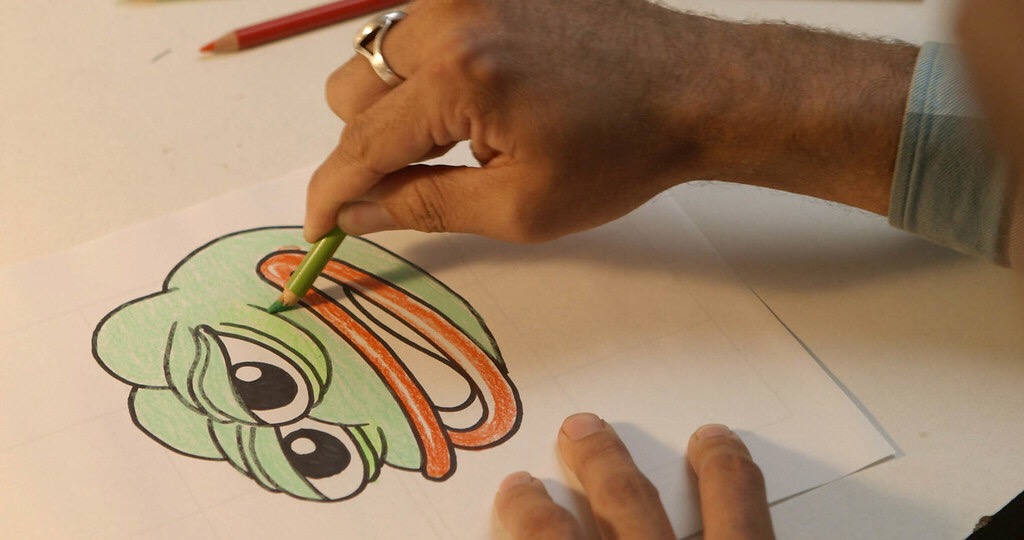Making its Sundance premiere, Feels Good Man, directed by Arthur Jones, is a perfect documentary of multidisciplinary value. In addition to being thoroughly entertaining, it offers an outstanding case study about social media, its role in politics, the framing of cultural identities, and the global dynamics of memes along with their strategic appropriation; the implications and protections of copyright, intellectual property and fair use, and the lessons for 21st century artists who are concerned about protecting the integrity of their creative efforts.
Certainly, this first-rate film should be in every media studies course, as Jones marvelously synthesizes many threads with the breadth and depth of sociological perspective that deepens the significance of films like these.
At the center is Matt Furie, a pop artist who truly epitomizes the Zen of Chill. On screen, the creator of Pepe the Frog and other characters that became part of the Boy’s Club comic strip is refreshing in his innocence and easygoing friendliness. The signature line “feels good man” came from Pepe the Frog pulling his pants all the way down to take a piss.

In the film, Furie remembers sharing his characters on his MySpace page, a fun cyberspace version of a school locker as he describes it, in the honeymoon days of social media engagement. It’s a fleeting reminder of just how our social media interactions did not just become more complex but also quite nefarious in disturbing moments. If Furie’s sociopolitical ideology could be summed up in a single phrase: it is be nice to each other and do good things, as he alluded to in an appearance following a Park City screening of the documentary.
Unquestionably, Furie underestimated the potent viral nature of social media memes (he mentions in the film how he was unaware of memes) when alt-right groups seized his creation to advance their pro-Trump, white nationalist, anti-Semitic causes. The film astutely draws the parallel to another significant figure: former presidential candidate Hillary Clinton who did not comprehend the depth of the pernicious and pervasive dynamics of a cyberspace environment where the sense of personal shame or embarrassment does not exist. Calling a group deplorable only emboldened that community’s resolve in appropriating characters and memes to suit their preferences. Jones sets up the context solidly in his film by highlighting the emergence of 4chan, 8chan, and Reddit communities and the unashamed pride of self-proclaimed members of NEET status (an acronym first used in the U.K. that spread to other developed economies describing young people as “not in education, employment or training”).
When the Anti-Defamation League (ADL) classified Pepe the Frog as a hate-inspired icon, Furie decided to reclaim the original creative intentions of his beloved character with a #SavePepe campaign. Previously, he enjoyed imitations and appropriations that celebrated Pepe the Frog’s lovable, even bittersweet, sense of chill and carefree attitudes. Furie, with his boyish charm and an admirable amount of self-effacing humor, had not registered copyrights to the image when he created it 15 years ago.
But now that his creation was hijacked for political ideas that he never imagined possible for connecting the image to, he hesitated at first about venturing into an arena where he would have to fight back or, as he says in the film, “lawyer up.”

The breaking point came when Infowars founder Alex Jones, the obnoxious opposite of the gentle Furie, sold a poster, priced originally at $17.76 apiece, featuring Pepe the Frog, along with images of himself, Trump, Ann Coulter, Milo Yiannopoulos and other celebrities associated with the far right, as well as the MAGA (“Make America Great Again) acronym. Claiming he had First Amendment rights to appropriate Furie’s creation, Jones bloviated about how he would prevail in the copyright infringement lawsuit, and raised the price of his poster to $29.95.
Prior to this, Furie, who was so desperate to stem the rising tides of hate that had overwhelmed the true nature of Pepe the Frog, “killed” the character off in a comic that featured his funeral. Of course, as the documentary shows, the alt-right community in its always bizarre misinterpretations of reality and legitimacy saw this as the “liberation” of Pepe the Frog.
The film documents the Infowars poster case deftly, without losing the light-hearted bounce that keeps the enthralling pace of its story telling. The lawyers who took his case pro bono worked their magic, issuing takedown notices, as allowed under the Digital Millennium Copyright Act (DMCA) provisions, against wretched websites such as The Daily Stormer.
Furie also finally registered his copyrights and licensing rights for the Pepe the Frog character, a delay which meant that he was not entitled to statutory damages or attorney’s fees in his Infowars lawsuit. But, justice prevailed, as the judge awarded him $14,000 plus an additional $1,000 which Furie contributed to a group working on conservation efforts for frogs. In the film, Furie says this was the most money he had received for his work with Pepe the Frog. And, Infowars had to destroy any remaining copies of the poster.

The director (Arthur Jones) packs the entertaining bits with important takeaways for any graphic artist or conscientious social media content creator. Register copyrights in a timely manner, as soon as possible within the time a creative work is completed. Also, having depositions taken is a grueling experience, as hilariously shown in the film. The lawyers, meanwhile, have given Furie the most impact on his campaign to reclaim the character.
The film covers a colorful range of curious, strange and even disturbing representations of Pepe the Frog (such as the young woman with her face painted green, persistently mispronouncing the character’s name as “pee pee”). Near the end of the film, Furie takes justifiable satisfaction in the latest appropriation of Pepe the Frog —the recent pro-democracy protests in Hong Kong that started with the anti-extradition march last June.
Young people in Hong Kong shared digital stickers via WhatsApp in images closer to Furie’s ideals, such as Pepe the Frog reclining on layers of pink clouds or casually giving the middle finger. He became the perfect reincarnation of the lovable irreverent ambassador that Furie always hoped his character would be.
Jones’ film brought a roaring standing ovation at the end of a screening in Park City’s Prospector Square Theater, boosted in decibels with the appearance of the gentle artist hero. Furie is not as immediately recognizable or familiar by name as, for example, Shepard Fairey or the anonymous Banks but he perhaps is the graphic artist whose imprint has had a far greater impact in numerous ways, especially in comprehending the intense polarization of our sociopolitical landscape and our capabilities for finding the better parts of ourselves in soul and community action.
The film, produced by Giorgio Angelini, Caryn Capotosto, Aaron Wickenden and part of Sundance’s U.S. documentary competition, is a project that received a Utah Film Center‘s fiscal sponsorship.
.
